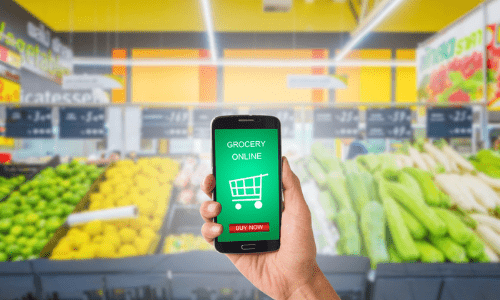By Nina Seth, Director Product Marketing – Commerce and Pawan Gupta, Sales and Strategy – Commerce
Online grocery sales are soaring to new heights. U.S. online grocery sales reached nearly $98 billion last year. In fact, more than 70% of U.S. households, or 93 million people, received one or more orders via pickup, delivery and ship-to-home channels. With changing expectations, grocers today need the right omni-channel technologies to help them manage and fulfill orders across channels. Progressive Grocer recently sat down with Blue Yonder’s omni-channel experts to discuss the challenges grocers face and the digital strategy initiatives they can implement to meet customer expectations.
Grocers face many challenges as they continue to weather the COVID-19 pandemic, including:
- lack of assortment and product availability due to supply chain issues and panic buying.
- labor shortages that affect their store and e-commerce operations as COVID-19 surges affect the number of staff available to work.
- providing product substitution options when the requested product is not available.
- evaluating the robustness of their inventory, order management and omni-channel fulfillment capabilities, especially as consumers embrace a hybrid shopping model.
While this may seem insurmountable, with the right omni-channel technologies, grocery retailers can not only manage ever-changing expectations but provide convenient and safe options to buyers as they shop digitally and physically in the stores. It not only creates a world-class customer experience but is able to boost margins and overall customer retention.
Let’s start with the advice regarding inventory management. In the growing hybrid model, it’s increasingly difficult for grocers to know how much inventory will be consumed through foot traffic versus online. But having an enterprise view of inventory can enable grocers to meet customer expectations. This involves understanding how much inventory is available and where, exposing just the right amount of inventory online to cater to e-commerce shoppers without limiting inventory for shoppers walking in. Another aspect of inventory is the ability to support real-time reservations. When consumers add products to their online cart, they expect to be able to purchase those items. Out-of-stock notifications after taking orders leads to poor customer experiences and lost sales when grocers are unable to fulfill the entire cart as promised.
With grocery e-commerce nearly $100B, grocers need to ensure that conveniences such as two-hour delivery, curbside pickup and next-day delivery don’t eat into profits. Order optimization can help offset and even lower the cost to serve by finding the most cost-effective way to fulfill an order. Additionally, with labor shortages plaguing the grocery retail sector, Blue Yonder’s solutions can improve worker productivity and optimize labor capacity. Luminate Order Fulfillment supports batch picking by store associates which can be highly productive because workers are able to pick many SKUs for several orders in one trip to the backroom, rather than picking one order at a time.
Leveraging machine learning (ML) capabilities, grocers can look at historical data showing them how many orders are fulfilled through various channels such as in-store versus curbside and BOPIS and then predict how much labor is required for each and at what time of the day. Lastly, investing in pick, pack and ship process improvements enables staff to work more efficiently and effectively while still meeting the needs of consumers.
The future is bright as grocers find ways to drive higher digital sales, and Blue Yonder is here to help drive success every step of the way. Learn how Blue Yonder’s order management capabilities can help grocery retailers better serve their customers while improving their bottom line. Watch our recent Progressive Grocer webinar to get more details on how we can help.

